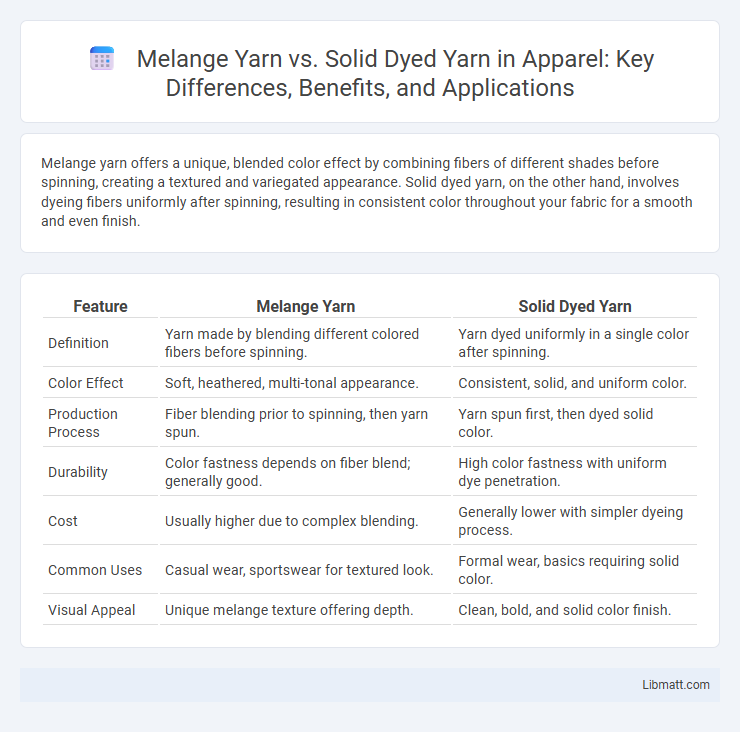Melange yarn offers a unique, blended color effect by combining fibers of different shades before spinning, creating a textured and variegated appearance. Solid dyed yarn, on the other hand, involves dyeing fibers uniformly after spinning, resulting in consistent color throughout your fabric for a smooth and even finish.
Table of Comparison
| Feature | Melange Yarn | Solid Dyed Yarn |
|---|---|---|
| Definition | Yarn made by blending different colored fibers before spinning. | Yarn dyed uniformly in a single color after spinning. |
| Color Effect | Soft, heathered, multi-tonal appearance. | Consistent, solid, and uniform color. |
| Production Process | Fiber blending prior to spinning, then yarn spun. | Yarn spun first, then dyed solid color. |
| Durability | Color fastness depends on fiber blend; generally good. | High color fastness with uniform dye penetration. |
| Cost | Usually higher due to complex blending. | Generally lower with simpler dyeing process. |
| Common Uses | Casual wear, sportswear for textured look. | Formal wear, basics requiring solid color. |
| Visual Appeal | Unique melange texture offering depth. | Clean, bold, and solid color finish. |
Introduction to Melange and Solid Dyed Yarns
Melange yarn is produced by blending fibers of different colors before spinning, creating a subtle, variegated effect with a multi-tonal appearance, while solid dyed yarn is uniformly colored through dyeing after the yarn is spun, resulting in consistent and vibrant color saturation. Melange yarn offers unique texture and depth, commonly used in fashion and upholstery for a sophisticated, heathered look, whereas solid dyed yarn provides a smooth, uniform finish ideal for bold, single-color designs. The choice between melange and solid dyed yarn depends on the desired visual effect, fabric characteristics, and application requirements.
What is Melange Yarn?
Melange yarn is a blended textile fiber, created by spinning together fibers of different colors to achieve a unique heathered or variegated appearance, enhancing fabric depth and texture. Unlike solid dyed yarn, which is uniformly colored throughout, melange yarn offers a subtle mix of tones that provides a distinctive, stylish look in garments and textiles. Your choice of melange yarn can add visual interest and complexity to fashion designs, making it popular in casual and contemporary apparel.
What is Solid Dyed Yarn?
Solid dyed yarn refers to yarn that is uniformly colored throughout its length using a single, consistent dye. This type of yarn ensures even and vibrant color application, resulting in fabrics with a smooth, monochromatic appearance. Compared to melange yarn, which blends multiple shades for a textured look, solid dyed yarn is preferred for designs requiring consistent and bold color intensity.
Production Process Comparison
Melange yarn is produced by blending fibers of different colors before spinning, creating a heathered or mixed color effect with a textured appearance. Solid dyed yarn undergoes a uniform dyeing process after spinning, resulting in a consistent and even color throughout the yarn. The melange production emphasizes fiber-level color blending for depth and variation, while solid dyed yarn focuses on post-spinning coloration for uniformity.
Color and Visual Effects
Melange yarns blend multiple fibers dyed in different colors before spinning, creating a textured, heathered appearance with subtle color variations and depth. Solid dyed yarns consist of uniformly dyed fibers, offering consistent, vibrant, and saturated colors without variation. Your choice depends on whether you prefer dynamic, multi-tonal fabrics from melange yarn or smooth, uniform shades from solid dyed yarn.
Durability and Performance
Melange yarn, made from blending differently colored fibers, offers enhanced durability due to its mixed fiber composition, which distributes wear evenly across the fabric. Solid dyed yarn, produced by coloring single fibers uniformly, provides consistent colorfastness and performance but may show wear more prominently over time. Both yarn types deliver strong performance, but melange yarn tends to resist fading and pilling better in high-use garments.
Environmental Impact
Melange yarn production reduces environmental impact by blending naturally colored fibers, minimizing the need for chemical dyes and water-intensive processes. Solid dyed yarn requires substantial water usage and chemical treatments, leading to higher pollution and energy consumption. Choosing melange yarn supports sustainable textile manufacturing with lower carbon emissions and reduced waste generation.
Applications in Textile Industry
Melange yarn, composed of fibers dyed before spinning, offers unique heathered textures ideal for casual wear, activewear, and upholstery textiles requiring visual depth and variation. Solid dyed yarn provides consistent, uniform coloration essential for formal garments, denim, and high fashion fabrics where precise color matching and clarity are critical. Textile manufacturers select melange yarn for versatile aesthetic appeal while choosing solid dyed yarn to achieve dependable colorfastness and design uniformity.
Cost Analysis
Melange yarn typically incurs higher production costs due to its complex process of blending different colored fibers prior to spinning, resulting in unique heathered effects. In contrast, solid dyed yarn involves dyeing a uniformly spun yarn with a single color, which is generally more cost-effective and efficient for large-scale production. Evaluating raw material expenses, labor intensity, and dye consumption highlights solid dyed yarn as the budget-friendly option, while melange yarn commands a premium for its distinctive aesthetic and production intricacies.
Choosing the Right Yarn for Your Needs
Melange yarn offers a unique, blended color effect created by mixing different colored fibers, resulting in a soft, visually textured fabric ideal for casual wear and innovative designs. Solid dyed yarn provides a consistent, uniform color that enhances durability and colorfastness, making it perfect for projects requiring precise color matching and longevity. Understanding your project's aesthetic and functional needs will help you decide whether melange yarn's artistic appeal or solid dyed yarn's reliability is the best choice for your garment or textile.
Melange Yarn vs Solid Dyed Yarn Infographic

 libmatt.com
libmatt.com